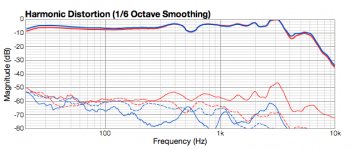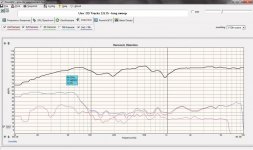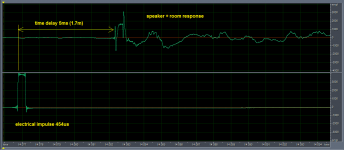Personally I doubt that something cheaper than ACO will actually meet with the quality of your other test equipment.
Back 45+ years ago, I had another problem. The only distortion measurement test equipment that I had was a Heathkit IMA, a Heathkit audio oscillator, and a Donner (vacuum tube) wave analyzer. Still, I needed a pretty good microphone to measure the distortion of individual drivers for the Wall of Sound we were designing for the Grateful Dead. I was fortunate in finding this B&K mike capsule, but it needed a preamp to make it whole. Still, I'm sure that my actual cost today would be between $500 and $1000 given the inflation over the years. Like any good tool, when you find something that actually works well, be it a hand tool, a loudspeaker, or even a measurement microphone, you tend to keep it indefinitely, because it doesn't really go obsolete like electronics does. Today, I have given away both my IMA and my wave analyzer, and I bought better test equipment over the decades. But I still have my measurement microphone, that I am sure still works OK for most anything, except extremely high frequencies, above 18KHz. The newer mikes aren't really much better.
Back 45+ years ago, I had another problem. The only distortion measurement test equipment that I had was a Heathkit IMA, a Heathkit audio oscillator, and a Donner (vacuum tube) wave analyzer. Still, I needed a pretty good microphone to measure the distortion of individual drivers for the Wall of Sound we were designing for the Grateful Dead. I was fortunate in finding this B&K mike capsule, but it needed a preamp to make it whole. Still, I'm sure that my actual cost today would be between $500 and $1000 given the inflation over the years. Like any good tool, when you find something that actually works well, be it a hand tool, a loudspeaker, or even a measurement microphone, you tend to keep it indefinitely, because it doesn't really go obsolete like electronics does. Today, I have given away both my IMA and my wave analyzer, and I bought better test equipment over the decades. But I still have my measurement microphone, that I am sure still works OK for most anything, except extremely high frequencies, above 18KHz. The newer mikes aren't really much better.
I think we should move this microphone stuff to a different thread.
I would be happy to make some measurements and share them of a handful of microphones. I just checked the mike preamps I have for the condenser microphones. The B&K 2639's have at least -96 dB HD2 and about -110 dB HD3 at the equivalent of 100 dBSPL with a 1" microphone (about 100 mV in). My two vacuum tube B&K's have about -60 dB HD2. I will be selling the vacuum tube preamps so if there are any questions that I should explore please bring them up before they are gone.
Is there any consensus on IM testing of a microphone being useful for predicting HD? Further should those IM sources be HF or lower frequency? I was thinking of using 250Hz and 350 Hz from two separate speakers however I need some validation since this stuff takes a lot of time.
I suspect the bulk of the "measurement microphones" of the Behringer ECM8000 type all come from one Asian vendor so maybe I'll get one of those and I have capsules from Primo and Panasonic (discontinued for several years) so once setup I can run several through the testing.
I would be happy to make some measurements and share them of a handful of microphones. I just checked the mike preamps I have for the condenser microphones. The B&K 2639's have at least -96 dB HD2 and about -110 dB HD3 at the equivalent of 100 dBSPL with a 1" microphone (about 100 mV in). My two vacuum tube B&K's have about -60 dB HD2. I will be selling the vacuum tube preamps so if there are any questions that I should explore please bring them up before they are gone.
Is there any consensus on IM testing of a microphone being useful for predicting HD? Further should those IM sources be HF or lower frequency? I was thinking of using 250Hz and 350 Hz from two separate speakers however I need some validation since this stuff takes a lot of time.
I suspect the bulk of the "measurement microphones" of the Behringer ECM8000 type all come from one Asian vendor so maybe I'll get one of those and I have capsules from Primo and Panasonic (discontinued for several years) so once setup I can run several through the testing.
I'm on this. I own a Gefell MK301 1/4" capsule with 1/2" adapter that I assume is a reasonable baseline for mic distortion. Just need to build a new buffer for it, as the cheep chinese B&K 2639 + supply/gain-stage knock-off I also have is junk (it works basically but is so extremely microphonic to be unusable in practice, also I don't know if they copied the circuit properly, there is a lot of hum and ULF-drift/noise in the output signal).
With this I should be able to compare to the performance of the cheap Transsound capsules (with a variant of the bootstrapped buffer Scott Wurcer shared here).
With this I should be able to compare to the performance of the cheap Transsound capsules (with a variant of the bootstrapped buffer Scott Wurcer shared here).
I made an LTspice jig to synthesize an N-wave based on the first null frequency. If I need to I can try to remove the nulls this way.
I found another reference from the same 2012 conference that you should look at, this reads directly onto my original reference (Wyberg) and my results. They quote some calculations using non-linear acoustics to get a more accurate model which looks almost exactly what I measured. Their figure 4 is almost exactly what I see (with different time constants to fit my spark and mic). They have some info and measurements that you might find useful.
https://hal.archives-ouvertes.fr/hal-00810828/document
There is need to know the thd/harmonics of the DUT --- without knowing the thd of the measuring system is a No-Go for me.
So. here is some useful data for you to think about.... The 1/2 inch diameter mic made under the Dayton and other names has harmonics in the 0.1 - 0.25% range at 90db SPL.
0.1% at 500Hz region.
This is marginal, but price is right, so I think we could use them for most things related to dynamic speaker/driver design and mods.
Thx-RNMarsh


[Dayton OmniMic, EMM6, ECM-8000, MiniDSP, etc]
So. here is some useful data for you to think about.... The 1/2 inch diameter mic made under the Dayton and other names has harmonics in the 0.1 - 0.25% range at 90db SPL.
0.1% at 500Hz region.
This is marginal, but price is right, so I think we could use them for most things related to dynamic speaker/driver design and mods.
Thx-RNMarsh


[Dayton OmniMic, EMM6, ECM-8000, MiniDSP, etc]
Last edited:
Is there any consensus on IM testing of a microphone being useful for predicting HD?
This is the most important thing, the other mic stuff is probably a distraction here. I certainly understand how tedious it can be taking measurements especially when you have to apply your own judgement on the methodology and possible confounders.
Isn't IM just a different representation of the one and same non-linearity as HD??? So why to worry?
Isn't IM just a different representation of the one and same non-linearity as HD??? So why to worry?
I would think so, there have been several papers on it here from industry leaders.
The electrets seem to be fine for this ??
See # 12665 above.
If the dynamic driver mods leave us with <0.1% then we have to go to the more expensive mic's.
But then, if it is <0.1% maybe we dont care below that?
Anyway, one of those electret's is what i will be using for now.
-RNM
Demian -- if you want to measure IM on electret microphones, One of the cheapest is the EMM6 spec'ed at 1% THD at 127db SPL.
See # 12665 above.
If the dynamic driver mods leave us with <0.1% then we have to go to the more expensive mic's.
But then, if it is <0.1% maybe we dont care below that?
Anyway, one of those electret's is what i will be using for now.
-RNM
Demian -- if you want to measure IM on electret microphones, One of the cheapest is the EMM6 spec'ed at 1% THD at 127db SPL.
Last edited:
Demian -- if you want to measure IM on electret microphones, One of the cheapest is the EMM6 spec'ed at 1% THD at 127db SPL.
http://www.daytonaudio.com/media/resources/390-801--dayton-audio-emm-6-quick-reference-guide.pdf
VERY flat FR. Well under 100 USD.
-RNM
Then buy the Dayton and take a chance, Richard. Following the guidelines that I have already stated, this microphone should have low enough distortion at 100-110 SPL for most measurements. The Dayton company most probably has already done the distortion comparison with a reference mike. Just use the highest voltage specified to power it, to keep the electronics linear.
IM in this case is just an easier way to test for distortion in a microphone. Linear sources are costly, so if you use 2 separate sources, then their individual non-linearities that generate their harmonic distortion from a single tone can be ignored (on a graph) and the microphone's distortion estimated. It just gets more confusing to use it for any other reason.
Last edited:
Then buy the Dayton and take a chance, Richard. Following the guidelines that I have already stated, this microphone should have low enough distortion ....
I dont need to buy one, I already own it and several others similar to it. But other DIY's might be interested in buying it to do their own testing and driver mods. .
-RNM
Then what is your question? You have already 'solved' your problem.
Well, since no one else solved the question of what is the distortion of the microphone or the "problem", I researched it further myself. As was pointed out, the capacitor mic could be low enough in distortion though very expensive.
I found what I have will work at low cost and reported that here for others interested.
Now we can continue with JN's suggestions on how to lower the THD of drivers.
THx-RNMarsh
Last edited:
Drivers have arrived (Monacor SPH-135TC). Quick test shows that the coils are not perfectly matched, certainly they are not bifilar wound. One coil is definitely hotter (higher resulting BL) and I will use this coil for the JN-feedback with a bit of attenuation to get the matching. Exact amount will have to be determined by measuring the back-EMF voltage with external exitation and trim the attenuation for deepest null.
Drivers have arrived (Monacor SPH-135TC). Quick test shows that the coils are not perfectly matched, certainly they are not bifilar wound. One coil is definitely hotter (higher resulting BL) and I will use this coil for the JN-feedback with a bit of attenuation to get the matching. Exact amount will have to be determined by measuring the back-EMF voltage with external exitation and trim the attenuation for deepest null.
Also of concern is the positional dependence on inductance, as they are probably different.
jn
Speaker time response
I hope this is something that John C might like to see 😉. It is a 2-way speaker response to a 454us wide rectangular impulse. Bottom trace is the el. impulse, top trace is the speaker&room response. Time delay about 5ms is the time needed for sound to travel from the speaker to the microphone.
I hope this is something that John C might like to see 😉. It is a 2-way speaker response to a 454us wide rectangular impulse. Bottom trace is the el. impulse, top trace is the speaker&room response. Time delay about 5ms is the time needed for sound to travel from the speaker to the microphone.
Attachments
- Status
- Not open for further replies.
- Home
- Member Areas
- The Lounge
- John Curl's Blowtorch preamplifier part III
